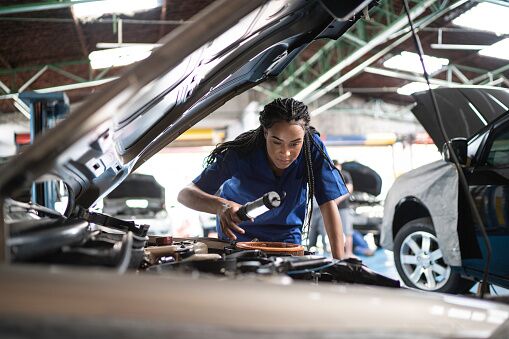All Categories
Featured

Keeping your automobile's tires is necessary to make certain a smooth, safe, and effective driving experience. 2 crucial solutions that are often overlooked yet have a substantial effect on tire longevity and efficiency are tire rotation and alignment. These solutions aid maintain your lorry running effectively and stop unequal tire wear that can impact both safety and gas economic climate. Let's dive into what tire rotation and alignment are and why they're essential for your car.
What Is Tire Rotation? Tire turning is the process of relocating your tires from one setting to another to ensure they put on evenly. Given that your cars and truck's tires function at different rates relying on their setting (front tires versus rear tires), rotating them routinely helps to distribute the wear uniformly, causing a much longer lifespan for your tires.
Tires on the front axle often tend to use more swiftly than those on the back axle, specifically in front-wheel-drive vehicles, where the front tires handle both guiding and power. On the various other hand, rear tires could put on erratically relying on the lorry's weight distribution and driving conditions. By revolving your tires every 6,000 to 8,000 miles (or as suggested by the supplier), you'll make certain a more well balanced wear pattern.
What Is Tire Placement? Tire alignment, likewise referred to as wheel positioning, refers to changing the angles of your car's wheels to the maker's specs. Appropriate placement guarantees that your tires are directing in the appropriate instructions, and it assists make best use of tire life and boost car handling. There are 3 primary facets of placement: camber, caster, and toe.
Camber describes the tilt of the tires from the front of the automobile. If your tires are slanted as well much inward or exterior, it can create uneven wear. Wheel refers to the angle of the guiding axis when seen from the side of the vehicle. This impacts the stability of the guiding, particularly when driving directly. Toe refers to the angle at which the tires aim internal or outward when watched from above. This impacts exactly how your vehicle tracks on the road. A proper alignment makes certain that all four tires are aiming straight ahead and are angled properly. Misalignment can arise from hitting pits, curbs, or just from the wear of suspension components in time.
Why Tire Turning and Alignment Issue. Extended Tire Life. Both tire turning and positioning aid stop uneven tire wear. When your tires use uniformly, they last much longer, which can conserve you money in the future by minimizing the requirement for early replacements.
Improved Security. Appropriate tire rotation and alignment boost automobile stability and handling. Misaligned tires or unevenly worn tires can adversely impact your capability to guide and quit your automobile, especially in emergency situation circumstances. Regular upkeep guarantees your tires carry out efficiently, offering a safer driving experience.
Better Fuel Efficiency. If your tires are not lined up properly, they may drag against the road surface area, causing resistance. This extra friction can reduce fuel performance, triggering your automobile to eat even more gas. Routine tire placement makes sure that your vehicle moves efficiently, improving gas mileage.
Improved Convenience. Imbalance or erratically worn tires can bring about a rougher trip, as your vehicle may draw away or trigger resonances. By maintaining your tires revolved and straightened, you'll delight in a smoother and a lot more comfy driving experience.
Indicators That Your Tires Required Rotation or Positioning. It's important to remain alert for any indications that your tires require rotation or placement. Watch out for these common indicators:
Irregular Tire Wear: If you notice that one tire is considerably more used than the others, it might be time for a turning or positioning. Guiding Pull: If your car draws away while driving right, this can suggest imbalance. Resonances: If you really feel resonances in the guiding wheel or the cars and truck itself, it could be an indication of imbalance or unequal tire wear. Squealing Tires: Uncommon tire sound can additionally suggest incorrect positioning or the requirement for a tire rotation. Just how Usually Should You Revolve and Align Your Tires? Tire rotation need to generally be done every 6,000 to 8,000 miles or as specified in your car's owner's handbook. It's an excellent idea to turn your tires during every oil adjustment, as this will help you remain on top of normal maintenance.
When it comes to positioning, it does not require as constant service. Commonly, positioning needs to be checked at the very least yearly or whenever you discover concerns like drawing away or resonance. You may also require placement if you've hit a huge crater or aesthetic, which can throw your wheels out of placement.
Conclusion: Keep Your Tires in Top Shape. Tire rotation and alignment are important services that maintain your car running smoothly, securely, and successfully. By taking the time to have your tires revolved and lined up routinely, you're spending in your auto's efficiency and long life, while additionally boosting your safety when traveling. Remain positive with tire upkeep, and your vehicle will thanks with better fuel economic situation, enhanced handling, and expanded tire life.
Latest Posts
Comprehending Tire Rotation and Placement: Why They Matter for Your Automobile
Stylish and Timeless Occasion Experiences
Expert Industrial Roofing Solutions - Weathercraft General Contracting Experts.
More
Latest Posts
Comprehending Tire Rotation and Placement: Why They Matter for Your Automobile
Stylish and Timeless Occasion Experiences
Expert Industrial Roofing Solutions - Weathercraft General Contracting Experts.